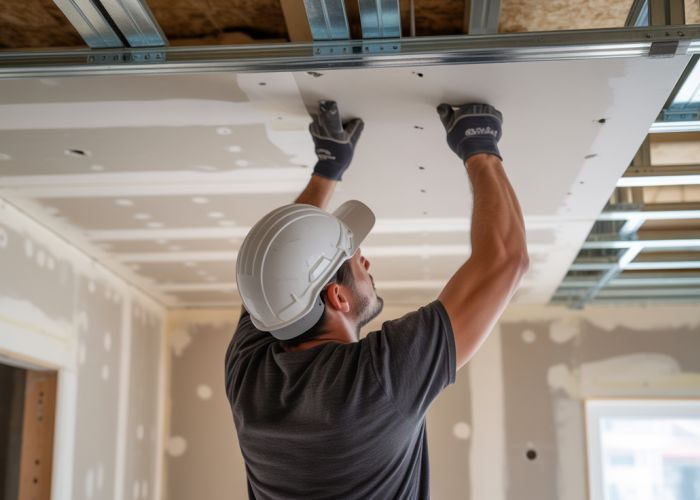When undertaking a ceiling renovation project, ceiling drywall thickness emerges as a crucial consideration. Drywall installation professionals understand that the required thickness often depends on the joist spacing, a structural element that directly impacts the support needed. Incorrectly gauging the ceiling drywall thickness can lead to sagging and potential future repairs. USG Boral, a leading manufacturer of drywall products, offers various thicknesses, and selecting the right one can significantly contribute to the overall durability of the ceiling. By taking all this into account, determining the optimal ceiling drywall thickness can avoid a costly and frustrating error.

Ceiling Drywall Thickness: Optimizing Your Choice
Choosing the correct ceiling drywall thickness is crucial for safety, aesthetics, and long-term structural integrity. Selecting the wrong thickness can lead to sagging, cracking, and even potential ceiling collapse. This article explores the factors influencing the optimal "ceiling drywall thickness" for various applications.
Understanding Standard Drywall Thicknesses
Drywall, also known as gypsum board or wallboard, comes in various thicknesses, each suited for specific applications. When considering ceiling drywall, you’ll typically encounter two common options: 1/2-inch and 5/8-inch.
- 1/2-inch Drywall: This is the most common and versatile type. It is frequently used for walls and ceilings when framing is spaced 16 inches on center.
- 5/8-inch Drywall: This thicker option provides greater rigidity, fire resistance, and sound dampening. It is often required by building codes for ceilings, especially in multi-family dwellings and commercial buildings.
Factors Influencing Ceiling Drywall Thickness Selection
Several factors determine which "ceiling drywall thickness" is most appropriate for your project. Failing to account for these can lead to problems down the line.
Framing Spacing
The spacing of your ceiling joists is a key determinant. Wider spacing necessitates thicker drywall.
- 16 inches on center (OC): 1/2-inch drywall is typically suitable.
- 24 inches on center (OC): 5/8-inch drywall is highly recommended, and sometimes required by code, to prevent sagging.
Fire Resistance Requirements
Building codes often mandate specific fire-resistance ratings for ceilings, especially in attached garages and between dwelling units. 5/8-inch drywall offers superior fire resistance compared to 1/2-inch drywall due to its increased gypsum core.
- Attached Garages: Often require 5/8-inch Type X drywall. Check your local building codes.
- Multi-family Dwellings: 5/8-inch drywall is frequently required between units for fire separation.
Sound Dampening
If soundproofing is a priority, 5/8-inch drywall offers better sound dampening qualities than 1/2-inch drywall. The added mass helps to block sound transmission.
- Home Theaters: Thicker drywall can enhance the audio experience.
- Bedrooms: Reducing noise from above can improve sleep quality.
Budget Considerations
While 5/8-inch drywall offers several advantages, it is generally more expensive than 1/2-inch drywall. Consider your budget when making your selection, but don’t compromise safety and code compliance.
- Material Costs: 5/8-inch drywall typically costs 20-30% more than 1/2-inch drywall.
- Installation Costs: Heavier drywall can increase labor costs.
Existing Ceiling Conditions
The condition of your existing ceiling may influence your choice. If you are covering an existing ceiling, consider whether the added weight of thicker drywall will place undue stress on the existing structure.
A Quick Reference Table for Choosing Ceiling Drywall Thickness
This table summarizes the key factors discussed above and provides a guideline for selecting the appropriate "ceiling drywall thickness".
| Factor | 1/2-inch Drywall | 5/8-inch Drywall |
|---|---|---|
| Framing Spacing | 16 inches OC or less | 24 inches OC (Highly Recommended), often required by code |
| Fire Resistance | Standard applications, check local codes | Required for attached garages, multi-family dwellings (check local codes) |
| Sound Dampening | Minimal | Superior sound dampening |
| Cost | Less expensive | More expensive |
| Weight | Lighter, easier to handle | Heavier, requires more support during installation |
| Ceiling Span Considerations | Smaller spans are generally more suitable | Larger spans are generally more suitable. |
Important Considerations for Installation
Regardless of the "ceiling drywall thickness" you choose, proper installation is crucial for preventing problems.
- Proper Fastening: Use drywall screws specifically designed for ceilings, and space them appropriately (typically 12 inches OC).
- Staggered Seams: Stagger seams to avoid continuous joints, which can weaken the ceiling.
- Adequate Support: Use temporary supports (T-braces) during installation to prevent the drywall from sagging before it is fully secured.
- Professional Installation: If you are not experienced with drywall installation, consider hiring a professional to ensure the job is done correctly.
FAQs About Ceiling Drywall Thickness
Here are some frequently asked questions to help you determine the right ceiling drywall thickness for your project.
What drywall thickness is generally recommended for ceilings?
Typically, 1/2-inch thick drywall is recommended for most ceiling applications. However, if your ceiling joists are spaced further apart than 16 inches on center, you should strongly consider using 5/8-inch thick drywall for added support and to prevent sagging.
When should I definitely use 5/8-inch ceiling drywall thickness?
You should absolutely use 5/8-inch drywall when joist spacing exceeds 16 inches on center. This thicker drywall offers superior resistance to sagging and helps create a more stable and even ceiling surface, especially crucial over larger spans.
Can I use thinner, 3/8-inch drywall for ceilings?
While 3/8-inch drywall exists, it is generally not recommended for ceiling applications. Its thinner profile lacks the necessary rigidity and strength to prevent sagging, especially over time. It’s better suited for curved walls or laminating over existing surfaces, not as a primary ceiling material.
What happens if I use the wrong ceiling drywall thickness?
Using drywall that is too thin for your ceiling can lead to sagging, cracking, and even eventual collapse. The weight of the drywall, combined with gravity and potential moisture, can cause thinner panels to bow between the joists. This can result in costly repairs and a less-than-ideal finished ceiling.
So, there you have it – everything you need to know about ceiling drywall thickness! Hopefully, you’re now equipped to make the best decision for your project. Happy installing, and remember: the right thickness makes all the difference!